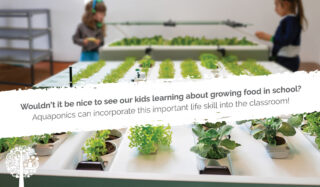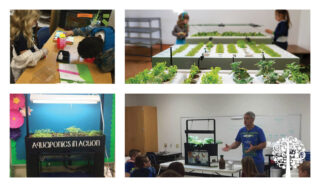We live in a time when gardening and growing food are more important than ever. Piquing children’s interest is essential so they can help heal the planet as we grow older. While parents can do their part at home, integrating gardening and various growing methods into the school curriculum is an excellent way to get kids started on this adventure. From outdoor gardens to hydroponic and aquaponic systems, teachers today have incredible tools at their disposal!
My kids are lucky to attend a school with a beautiful food garden on the front lawn. In the spring, students amend the soil and plant the seeds. In the fall, they help with the harvest and reap the benefits. They don’t understand how much they learn while working in the garden. Practical life skills that also cover a wide range of subject matters, including math and science.

But being an outdoor garden, the growing stops throughout our long Canadian winter. I’ve recently been learning about aquaponics and how it can offer students incredible learning opportunities and nutritious food year-round!
What Is Aquaponics?
Aquaponics creates the perfect harmony between raising fish and growing plants. The two coexist in a recirculating ecosystem where the fish waste fertilizes the plants, and the plants clean the water for the fish!

You can grow many varieties of plants in an aquaponics system, including fresh herbs, strawberries, peppers, tomatoes, lettuce greens, and more. The symbiotic relationship between the plants and fish means that nutrients, oxygen, and water are abundant, and the plants don’t need to compete with each other. You can space crops much closer together than in a soil garden.
Types of fish that do well in an aquaponics system include tilapia, koi, catfish, and goldfish if you’re not planning on eating the fish. According to Sylvia Bernstein, author of Aquaponic Gardening, the typical rule of thumb is one fish for every 5 gallons of water.
Why Is Aquaponics Important?
With many concerns about farmed fish and the bacteria in those environments and many recent listeria outbreaks in lettuce crops, aquaponics is an entirely different concept that produces lots of clean, nutritious food and plants using a fraction of the water used for growing crops in soil.
This growing model is eco-friendly, convenient, and can be used year-round. An aquaponics system can be integrated into communities with limited access to fresh food, reducing food miles and creating jobs. The tanks also come in various sizes and can fit into any space, whether a community center, classroom, or living room.
Many existing initiatives have incorporated aquaponics systems into the classroom. According to The Aquaponics Source, this growing method covers many core STEM subjects, including math, biology, chemistry, and engineering.
They study fish, plants, and bacteria, all working together to create a vibrant and mutually beneficial ecosystem. Students can also learn how to do a water quality test and measure or track the growth of the fish and plants.
Outside of the core subjects, growing using an aquaponics system can help students learn the ins and outs of marketing, economics, and nutrition!
Various systems exist to fit any classroom size. Smaller ones can accommodate a few food crops for one class and some goldfish below, which might help with therapy for students in need. Larger ones can be placed in a communal setting where all students can visit and learn.
Research!
Research must be done before incorporating an aquaponics system into a school. Many aquaponics organizations and businesses exist, and you might find some opportunities for grants to help you with the process. After looking into it, I don’t doubt that aquaponics covers many bases in an educational setting while teaching essential life skills.
Can you tell me what the best type(s) of fish and amount of is the correct ratio for a aquaponics system with a 10 gallon tank would be? (just like the system posted above)